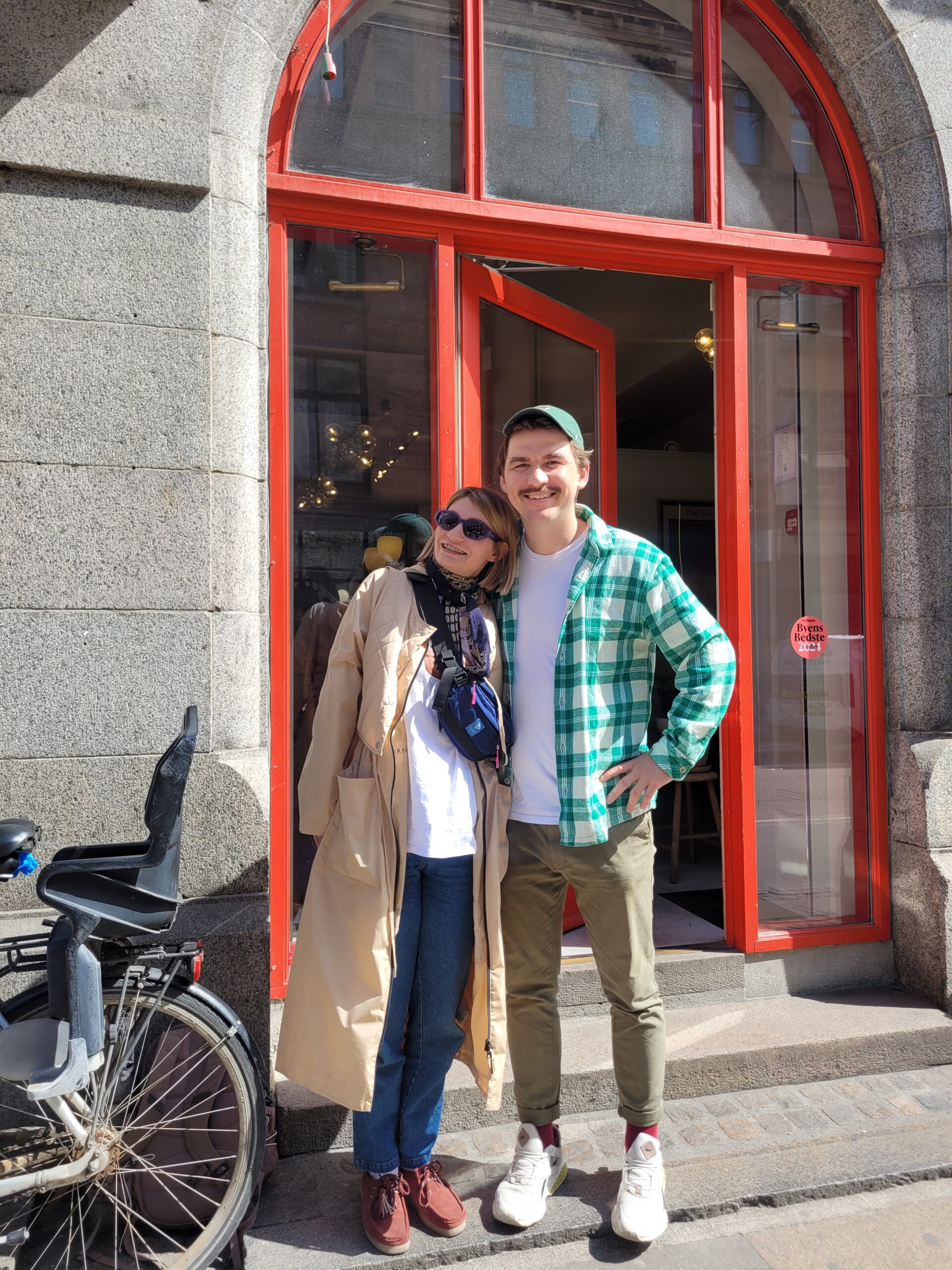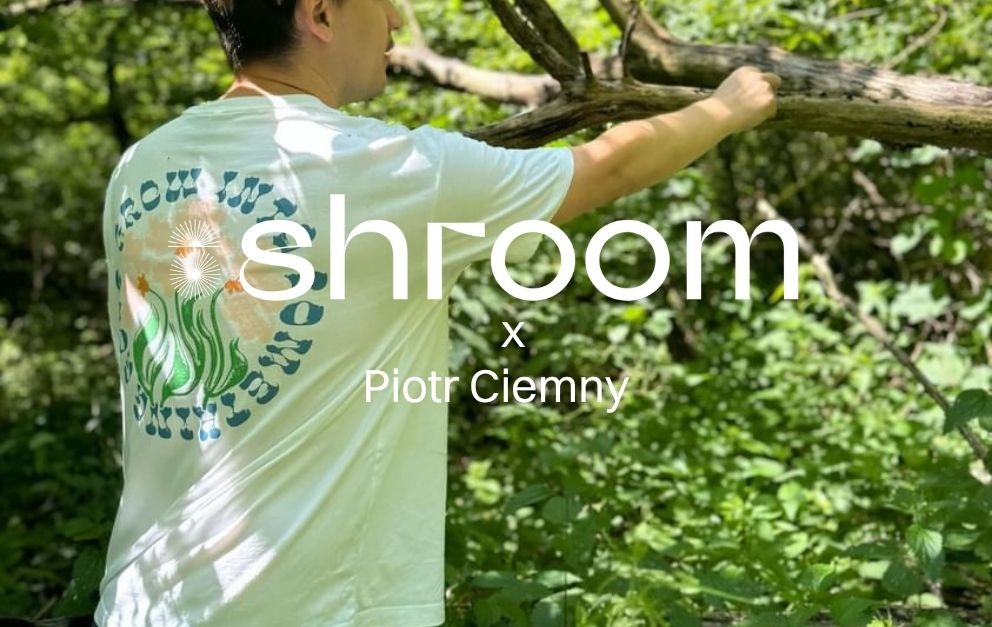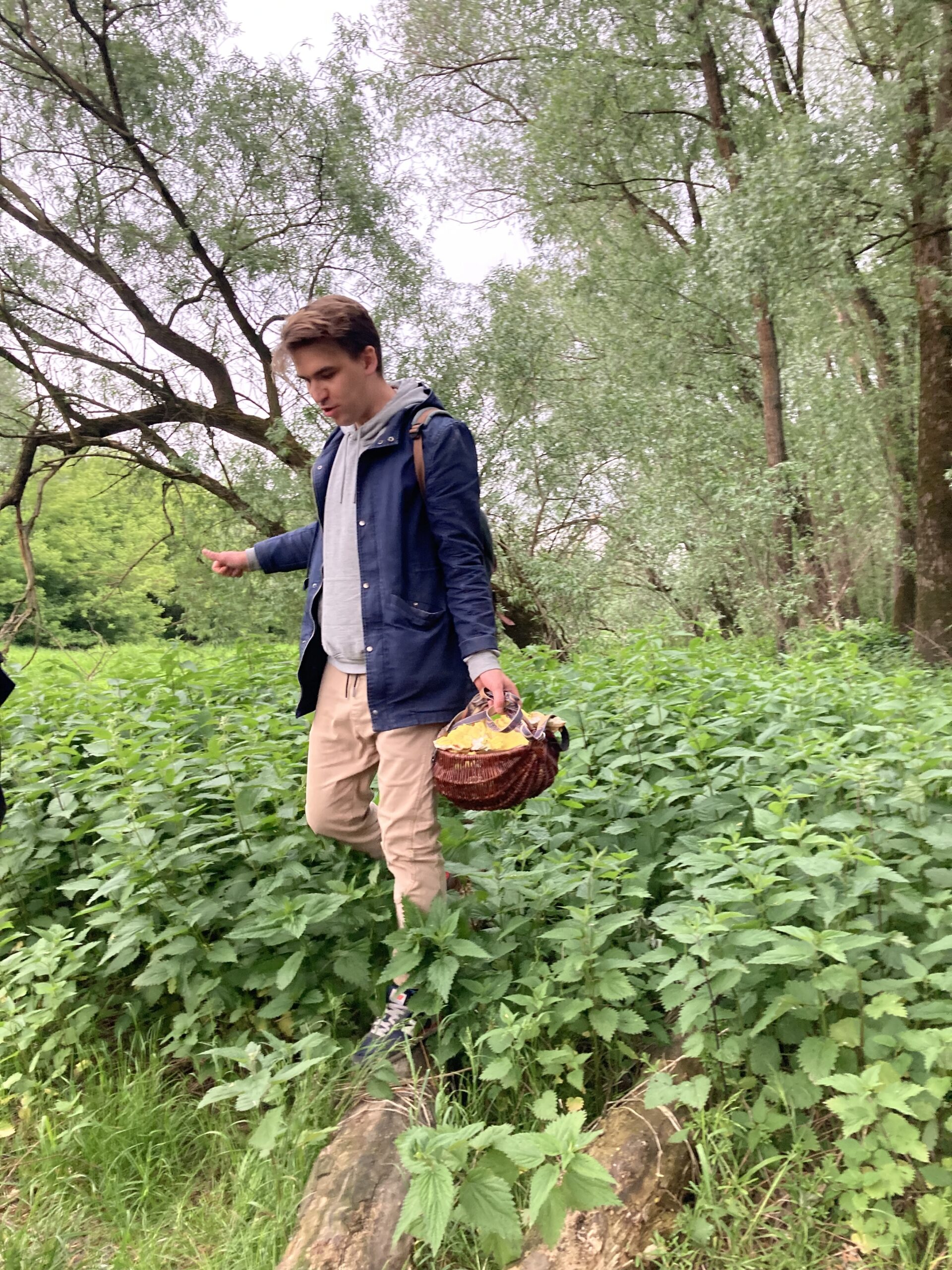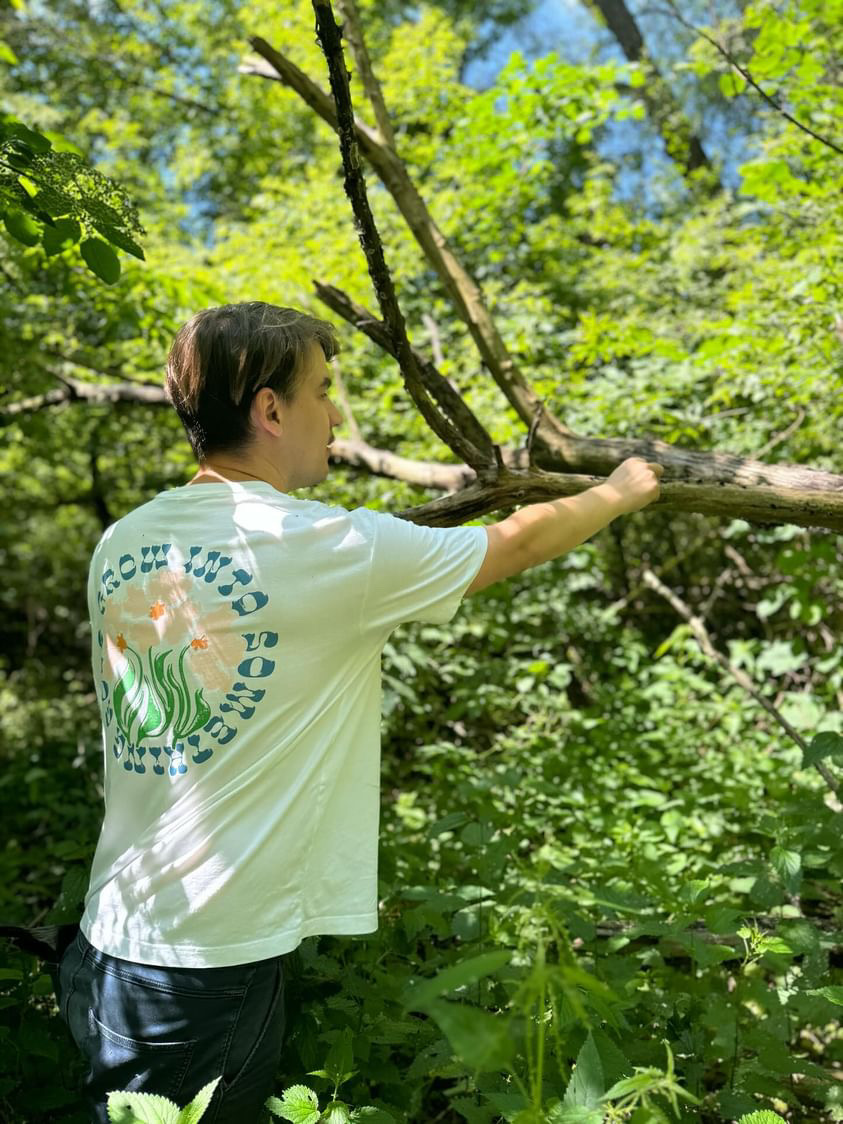When I ask Piotr Ciemny who he’d like to be in the future, he answers without hesitation: “A mushroom. Or a millennial’s dog.”
And only then he adds that, truthfully, he’s just… happy. And it’s hard not to believe him — after all, we’re talking about a man who can walk halfway across Copenhagen in search of sea kale, and whose greatest superpower is noticing beauty in, well… weeds.

Fot. Archiwum Piotra Ciemnego
We met Piotr in a busy café in Copenhagen’s historic center.
Interview:
Kamila Knap, Shroom: We last met in Warsaw, and now here we are in Copenhagen. What brought you here?
Piotr Ciemny: I think peace and relaxation. I work at Aamanns 1921 as a sous chef and I’m learning about Danish smørrebrød and their regional cuisine. I’m often in Poland, but usually for specific events — dinners, pop-ups, events, and other cool things. Actually, as we talk today, it’s exactly a year since my third book came out—I got the notification this morning [we met a few months ago, but publication was delayed, ed.]. I wanted to do the same things here that I did in Poland—picnics, herbal walks—just here in Copenhagen. Recently I decided to walk along the seashore because I’m constantly searching for sea kale. I walked all the way to Dragør, which is a great little town outside Copenhagen. It’s amazing—you can walk from one town to another and just take the bus home.
I love Copenhagen too; I feel incredibly calm here. The fastest people here are runners and cyclists. Where did your passion for weeds and wildness come from?
It all began in 2017 when I worked at restaurant 108 in Copenhagen. That place doesn’t exist anymore, but that’s where I met someone who taught me a lot—his name was Michael. He now runs a company that gathers wild herbs and has his own farm. I went foraging with him for the first time. It was 7 a.m., and afterwards I was completely exhausted. That foraging knocked me out. But it was a real game changer for me. It opened my eyes—I saw that you could do something genuinely cool. I got completely hooked. For three years I was taking photos, but publishing nothing. In Poland, in the gastronomic scene, it was still common that if chefs saw you had an interesting hobby or passion, they’d rather suppress it than support it—or treat it in a way that discouraged you. I’m the kind of person who has tons of ideas, but they often burn out before they start. Then I need another dopamine hit and…
ADHD?
Possible, but I don’t call it that yet. But yes—that’s how it feels. I have tons of ideas, after four weeks I decide it’s pointless, and then I come back to them again. I need space to develop a passion. Later I returned to Copenhagen, but then COVID happened, and Alchemist—the place I worked—was closed for months. Suddenly I had time, so I decided: fine, I’ll create an Instagram account. My first idea for the name was connected to wild herbs, but then I realized no one uses the word “chwasty” (weeds). And weeds are something a bit controversial, a hook. And that’s how it started—I began posting. I had 20 followers, now I have over 20,000. We recently passed the fifth anniversary of Weeds in the Kitchen. It used to be only about cooking, but now it’s my own herbal, weedy propaganda tube. I can write what I want, post what I want, share my views. And it’s not only about cooking, but also—though I don’t like the term—about sustainable living. There’s another way.
I feel like lifestyle is everything now. We usually don’t face dramatic moral choices, so our lifestyle reflects our ethics—whether we seek out information about the world and adjust our behavior based on the state of the ecosystem, fast fashion, consumption… or whether we simply ignore it and keep consuming happily.
Yes, exactly. Ignorance annoys me most. And there are so many words that have become empty—like “sustainable living” or “ignorance.” Repeated so often, polished by advertising slogans, that they lose their meaning. But coming back—I’m a living example that you can change your life, and it’s worth doing. I left Warsaw to finally find some peace, and I succeeded. I’m not constantly stressed anymore, I don’t have to prove anything to anyone. I go to work and that’s that. When you start joking at work, you know it’s good. And here, alongside a great team, I have room to grow my real passion.
What are your favorite weeds? Is that a hard question?
Yes, extremely hard. People ask it often, but it’s still hard. My favorites depend on the season. Usually I say chickweed (Stellaria), because it grows all year and you can find it basically anywhere—in the city or in the forest. Now I also get to forage coastal herbs. Sea pea is delicious—sweet and crunchy. There’s also sea sandwort. I’d have to divide them by category—where and when they grow. The unique ones are probably my favorites. There’s also garlic mustard, which almost no one recognizes. It has a flavor and aroma similar to overrated ramson, which I don’t like—but nobody picks garlic mustard. I like the underappreciated, forgotten, neglected ones. Those are my favorites.
I recently learned to use ground-ivy.
I have a funny story about ground-ivy. The promoter of my book said: “Just don’t talk about ground-ivy. Everyone talks about it.” When I went on TV, the first question was about ground-ivy, but I said I couldn’t talk about it because I had a ban.
Whew, glad it wasn’t my first question. A ground-ivy ban?
Yes. But ground-ivy is delicious. I was at the allotment recently and it grows there in huge quantities. It broke my heart that I couldn’t pick any because I was leaving for Copenhagen. It’s fantastic—very aromatic. When you cook broth, ramen, or stock, you can throw in ground-ivy at the very end. Remove the pot from the heat, toss the herb in, cover, and let it cool. I recommend it only for clear broths, because in other soups the flavor might get lost. It’s delicious—so much aroma.
So you infuse herbs rather than cook them?
Yes, fresh herbs should be added at the end. Don’t torture them. If you cook fresh herbs too intensely, they lose their aroma and flavor. Add them at the last moment. You can also dry herbs, but not all of them are suitable—many aromatic herbs turn into something like hay. For example, my favorite chickweed loses most of its charm once dried.
Most herbs—pretty much every herb I think of—loses a lot when dried. Is there any herb that actually gains something?
Yes—elderflower works great, even for cooking and infusing; it adds tons of aroma. Other flowers too, like forsythia. Wild berries also dry very well.
“Ostatnio stwierdziłem, że pójdę sobie brzegiem morza, bo cały czas szukam jarmużu morskiego. Doszedłem aż do Dragor, a to jest świetne miasteczko pod Kopenhagą”
Paradoxically, we’re afraid of wild herbs that grow locally, yet we’re not afraid to order avocados from the other side of the world.
Wild kitchen

Kamila Knap (Shroom) i Piotr Ciemny Fot. Bartosz Knap
Do you notice more interest in wild cuisine? I feel like people are more curious about wildness and alternative ingredients, but you don’t really see it reflected in stores or restaurant menus. Do you think it can develop professionally, or will the mass food supply chain swallow everything?
Over the last five years I’ve watched interest grow. But I feel the same—that there’s lots of talk but nothing enters the market. If someone wants to create a big wild-food event, it’s cool for one night, then it disappears. Even big brands that create “botanical series” mostly use… mint. They sign it off as super wild, natural—and then still use mint, thyme, and other classics.
Restaurants have a problem because you need paperwork for everything. I get that it’s about safety, but it blocks the use of wild, seasonal ingredients. Paradoxically, we’re afraid of wild herbs that grow locally, yet we’re not afraid to order avocados from the other side of the world. In Denmark, restaurants work with foragers who don’t have special certifications. It’s about mutual trust—which we often lack. At Amas, the restaurant I work in, we forage ourselves—like 20 kg of wild garlic, which we turned into oil. No paperwork. No one has paperwork. On Monday I’m going to pick garlic mustard flowers. Everything will be used. Everyone simply trusts that it comes from good places. There are no bans on foraging because there’s social trust. Sure, someone might damage something once in a while, but overall it works. Once, a Warsaw restaurant had a dinner where someone foraged outside. Immediately it became a scandal—how can you forage outside, where dogs walk, etc. I used to forage under my apartment block in Bródno [district of Warsaw]. Nothing ever happened to me—maybe I was just lucky. I’m not encouraging foraging under your block, but I feel we’re just over-polished—everything must be sweet, shiny, perfectly ready for the plate.
I envy those starting their adventure with weeds. Beautiful moments are ahead. You start knowing nothing. I’d love to return to that moment.
What caused the surge in interest in wild herbs?
During my years of foraging I noticed two big moments when lots of new people found me. The first was during the pandemic—many people wanted to forage. The second was when the war in Ukraine began—people got scared, wondering what they’d do if they ever ended up in a forest.
I wanted to brag a little—our Diva Social Elixir is based on niche fruits: sea buckthorn, cornelian cherry, and aronia. Our Danish distributor struggled even to find a translation for “cornelian cherry”—nobody knew the tree.
They have tons of sea buckthorn here. It even grows in the city center. Sea buckthorn immediately reminds me of Copenhagen—you can pick it everywhere here.
Do you have a pro tip for Shroom readers? How to start incorporating wild herbs into the kitchen?
Maybe it’s not a super tip, but—don’t go crazy at the beginning. Learn step by step. Slowly taste, photograph, compare plants. Make a small list to start with. Or just look at your feet. Take photos—we have great tools now. Not 100% accurate, but it makes your brain work. I compare it to collecting Pokémon. I even wanted to create an app like that, but when I learned how much it would cost, I gave up.
Just start—don’t overthink it. You don’t need to be a master. People get blocked—like my friend saying: “I won’t start fermenting; I’m not Aleksander Baron.” You don’t need to be Baron. You don’t need to do it perfectly. You can just start. We have this ambition that we must be masters at everything. We can’t be average. I forage wild herbs, but I don’t know all of them, or Latin names—I do it for myself, out of passion. Just start. First of all—leave the house. It sounds banal, but leave the house, take your headphones off, take your phone for safety, and go. Look around. Search for mushrooms, weeds, listen to a woodpecker drumming. If you find that tree, put your ear to it. Incredible. And that’s it. I’ve been foraging for five years and walking the woods, and I feel my sensitivity to nature and animals has increased a thousand percent. I used to be like that, but now I prefer the forest to people in the city.
Surprise us—what’s something unexpected you can forage?
Mushrooms on trees—that’s next-level. No competition, you can forage year-round. They’re beautiful. Not boring like ground mushrooms. A perfect metaphor. People living ordinary lives are like ground mushrooms—similar, all the same. And those who pop out, do something different—like your Diva—those are tree mushrooms. Easy to recognize, unique. Nobody does that. And they’re delicious, more aromatic. You don’t need to bend down—just look up. Fantastic. I feel like I know maybe 5% of the mushroom world. Maybe less. There’s a great book I once promoted—”Entangled Life”. It’s not about foraging mushrooms, but about understanding them.
Who would you like to be in the future?
If I had to pick who I’d be in the future—either a mushroom or a millennial’s dog, living like mine. Two great options.
Any final thoughts you want to share?
I can say I’m genuinely happy. I joke that I get stressed sometimes because nothing stresses me out. This is the point in life I’d been waiting for. I envy people coming to Copenhagen for the first time. I envy those starting their adventure with weeds. Beautiful moments are ahead. You start knowing nothing. I’d love to return to that moment.
Luckily life gives us many areas where we can be beginners. Thank you so much, and good luck to Weeds in the Kitchen!
In Copenhagen you can buy Shroom at the bars Rannor and Sohesten, and they’re offered by Real Drinks.
Rozmawiała: Kamila Knap Zdjęcia: Bartosz Knap, Archiwum Piotra Ciemnego
Piotr about himself
Founder of @chwastyodkuchni. A culinary enthusiast, weed-forager, and author of plant-based cookbooks. He prefers wild landscapes outside the city to urban jungles. A happy human to Dexter the dog.
Piotr’s Instagram: @chwastyodkuchni





